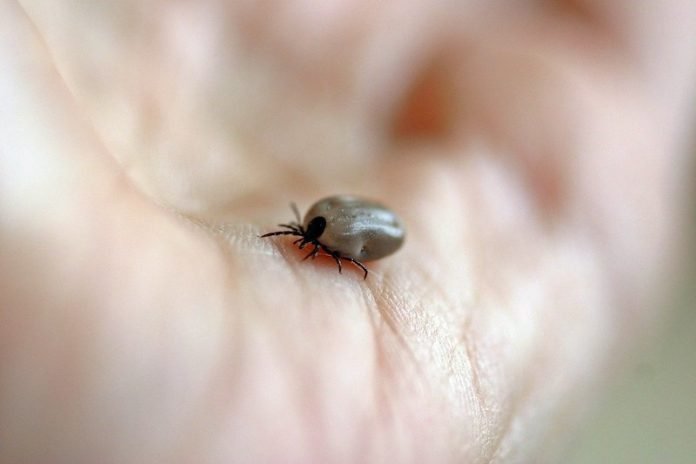
While summer typically means more time outside, the season also brings an increased threat of tick bites.
These parasites can be relatively harmless, but they can also carry and spread illnesses like Lyme disease.
We spoke with Mountainside Medical Group’s Crystal Tank, M.D., and Ashany Sundaram, M.D. to learn more.
“Lyme disease is caused by the bacterium Borrelia burgdorferi and less often, Borrelia mayonii,” Dr. Sundaram said.
“It is transmitted to humans and animals through the bite of an infected black-legged tick commonly known as a deer tick.
Most humans are infected through the bites of immature ticks called nymphs. Nymphs are tiny (less than 2 mm) and difficult to see; they feed during the spring and summer months.”
“Ticks can attach to any part of the human body but are often found in hard-to-see areas such as the groin, armpits and scalp,” Dr. Sundaram said.
“In most cases, the tick must be attached for 36 to 48 hours or more before the Lyme disease bacterium can be transmitted.”
If you find a tick on your body and believe you may have contracted Lyme, your doctor can run tests to confirm a diagnosis.
“Most Lyme disease tests are designed to detect antibodies produced by the body’s immune system in response to the infection,” Dr. Tank said.
“The lab test is a two-step process. Typically, if the first step is negative, then no further testing is needed. Antibodies may take a few weeks to develop after exposure, so it is important to check in with a doctor to determine if, and when, Lyme disease testing is necessary.”
Lyme disease can present itself in many ways. Based on the timeline of infection some individuals experience intense illness while others experience mild symptoms.
“How you feel with Lyme disease can depend on how long you have had it,” Dr. Tank said. “In the early stage, the first thirty days or so, it is most common to feel joint pain, fevers, chills and swollen lymph nodes with fatigue.
Approximately 70 percent of infected persons develop a rash in the shape of a target lesion, or ‘bull’s eye’ appearance.
In the later stages of the disease, without treatment, severe headaches, nerve pain, heart palpitations and joint swelling are common.
It’s even possible to develop what is known as Bell’s palsy, or facial paralysis involving facial droop on one or both sides of the face.”
Time is an important factor when dealing with a tick bite. Speak with a doctor immediately if you start experiencing symptoms after a tick bite.
“Antibiotics are used to treat Lyme infection,” Dr. Sundaram said. “Patients typically take doxycycline for 10 days to three weeks, or amoxicillin and cefuroxime for two to three weeks.
There is also a one-dose preventive treatment which is most effective if started within 72-hours of a known tick bite.”
If left untreated, Lyme disease can progress to include the following symptoms:
Severe headacheor neck stiffness
Rashes on other areas of the body
Arthritiswith severe joint pain and swelling, particularly in the knees
Loss of muscle tone or “drooping” on one or both sides of the face.
Heart palpitationor an irregular heartbeat
Inflammation of the brainand spinal cord
Shooting pains, numbness, or tingling in the hands or feet
Ticks are plentiful, especially outdoors in wooded areas, but there are some protective measures you can take to reduce your risk of a tick bite.
“The best way to prevent Lyme disease is to cover up your exposed skin in wooded areas. Connecticut and parts of New Jersey and New York have high rates of ticks carrying Lyme disease,” Dr. Tank said.
“Use a bug repellant that carries at least 20 percent of DEET chemical. Remove a tick with tweezers so that the whole tick is removed from the skin. Make sure to speak with a doctor if you have tick bites, and always check your entire body for ticks after potential exposure.”
Although Lyme disease can turn into a very serious illness, treatment can be effective in most cases.
“About 90% of people are cured of Lyme disease with treatment. In some cases, a patient may need extended IV antibiotic therapy,” Dr. Sundaram said.
“Ten percent of people do not respond to treatment and develop chronic Lyme disease. There is currently no cure for chronic Lyme disease.
People with this condition typically get better over several months with a doctor-curated treatment plan to help manage the symptoms.”
Speak with your doctor right away if you begin experiencing symptoms of Lyme disease. Visit www.mountainsidemedicalgroup.com or call 866-999-5162 to find a doctor near you. Virtual visits are available.
If you care about Lyme disease, please read studies about this new test could diagnose Lyme disease within 15 minutes and findings of this antibiotic can completely kill bacteria that causes Lyme disease.
Source: Hackensack Meridian Health



